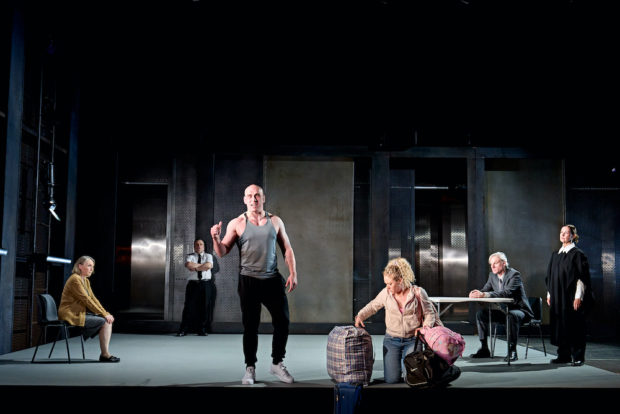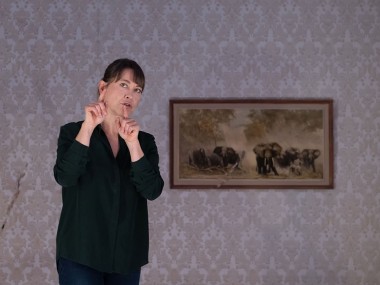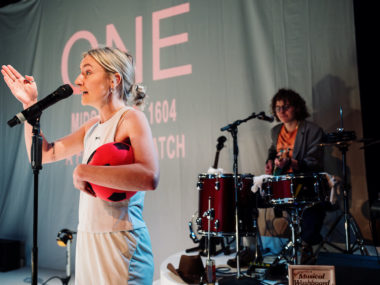Manhunt, Royal Court
Tuesday 8th April 2025

Are we really in “a new era of male anger, societal discontent and rage”? This is what Royal Court artistic director David Byrne claims in the programme of Manhunt, Robert Icke’s new documentary play. Weak thought, because surely there has never been a decade in which toxic masculinity was not a problem. Still, the current success of Jack Thorne’s Adolescence on Netflix certainly shows that we are more than ever fascinated by its roots in boyhood, but male rage has a very long backstory. All you have to do is read the Bible. Or scan the myths of ancient Greece (Icke’s speciality).
Like the 2023 ITV series The Hunt for Raoul Moat, Manhunt tells the story of the 37-year-old ex-convict who violently abused his partner Samantha Stobbart and his children, and then, when she left him in the summer of 2010, got a sawn-off shotgun and shot and killed her new boyfriend Chris Brown, shot and hospitalized her and then shot and blinded police officer David Rathband, who was just on traffic duty. Moat believed that the police were persecuting him, and this paranoia was increased when Samantha told him that Brown was a serving officer. He wasn’t, but she lied because she thought it would make her safe. It didn’t.
But while male violence against women is not new, neither in society nor in the theatre, Icke’s take on the subject is an intense and powerful experience. He focuses mainly on Moat himself and challenges the tendency of politicians, such as then-Prime Minister David Cameron, to simplify the case, as well as the equally reprehensible media habit of making killers into monsters. Or heroes. Icke’s careful research, which relies a lot on Andrew Hankinson’s 2016 book You Could Do Something Amazing with Your Life [You Are Raoul Moat], results in a convincing portrait of a violent Geordie and partly explains Moat’s aggression by depicting moments in his disturbed childhood.
The actual manhunt, which was the biggest in UK history and followed Moat’s shooting spree, lasted about seven days, but only occupies a small part of this 100-minute play. Icke uses a number of theatrical devices to make his documentary more lively: he creates a barrister who conducts a fictional prosecution of the killer, he allows Moat to address the audience directly, occasionally with a meta-theatrical twist. Details of the childhood of Moat, who was fatherless and whose mother was bipolar, give us glimpses of anguished humanity, even as the adult man raves about his rights as a bloke, as a parent and as a persecuted innocent (he wasn’t). On top of his toxic speeches he strides around threatening women, other men and children. There’s no problem with seeing him as a nasty piece of work.
This production follows Hankinson’s insight that Moat never really knew who he was, that he was playing a part, a caricature image of a Geordie strong man, interested in women and weights, a snarling fighter. At the very start of the show, he is pacing around the stage, obscured by a screen on which is projected his image from above, glistening bald head, lurid white trainers. Caged beast. But since the play shows how he was a stranger to himself, who didn’t know who he was at all, the sense you get is that he was just performing his masculinity. His maleness was an act.
The trouble was that Moat was unable to control this act. In a way, the stereotype of toxic masculinity was playing through him, without his awareness of its appalling nature. This lack of control had devastating consequences for everyone he came into contact with. But understanding this, and seeing him represented on stage not as a monster, but as a human being, both charming (occasionally) and horrible (usually), does present a moral challenge. Yes, we want to know more about him, and grapple with the question of why men behave like he did. But no, we are angry that he dominates the play — his victims, especially the women, being effectively sidelined.
Like Moat himself, Icke’s play is on steroids. Actor Samuel Edward-Cook is Moat, muscles bulging and sweating, a disturbingly powerful stage presence. Often terrifying. Not only does he speak the killer’s words with enormous conviction and blunt force, but he also enacts his murderous rage with a real feeling of danger. At one point he throws Samantha across the stage, crashing into a metal table; at another, happier moment, he spins around with her hanging from his body, but with a real risk of crashing. At yet another moment, he throws his daughter high into the air. All this feels risky, feels bad.
But Icke saves the worst of the bad stuff for Rathband, the blinded policeman who, like Moat, eventually commits suicide. Using his own words, he stages his monologue about Moat’s random attack on him in a total blackout, which represents his blindness while also intensifying the power of his chilling account of the violence. At other moments, brief scenes between Moat and Samantha, between Moat and the authorities, between Moat and his mate Karl, provide some material that was later formed into the image of him as a local legend, a working-class hero who fought the cops.
Sadly, Icke does not make enough of the wider picture, but stays focused on Moat the man. Not only is Edward-Cook’s performance overwhelmingly strong, his voice cracking when he mentions his kids, his rage blistering the stage, but the rest of cast are also excellent, even if their parts are much more sketchy. Sally Messham is good as the desperate and victimized Samantha, as is Danny Kirrane as Karl and Trevor Fox as the footballer Gazza, who wanted to talk to Moat in his final fatal showdown with the police, but was restrained by them: in this version, Icke gives him a fictional meeting in which both men compare notes about northern English manhood.
Even if we can agree that traditional stereotypes of masculinity find vulnerability an unbearable feeling, preferring the aggressive acting out of rage, it is still difficult to completely comprehend men like Moat. What you remember is him pointing his shotgun at the audience, rather than the little glimpse of the injured boy. Still, Icke’s direction flows very smoothly on Hildegard Bechtler’s set, with its steel panels, exuding a sense of hardness even as Moat says he feels helpless as well as angry, while Ash J Woodward’s videos use Moat’s texts and FaceBook posts to good effect.
If the play is a bit too long, maybe the subject does need this kind of complete immersion. But while audiences might struggle to equate damaged children with vicious killers, and be skeptical that people only listen to enraged men when they perform violent acts, Manhunt does deliver a body blow to liberal pieties. We’d like to believe that therapy would have helped Moat, but the evidence suggests otherwise. Finally, this is not the first, nor the last, play to tackle toxic masculinity. Sadly, unless you give these stories about men an extra dimension of gender fluidity or confusion — as in Richard Gadd’s Baby Reindeer — they really do end up all by saying the same thing. Victimizers are victims too.
This review first appeared on The Theatre Times
- Manhunt is at the Royal Court until 3 May.




